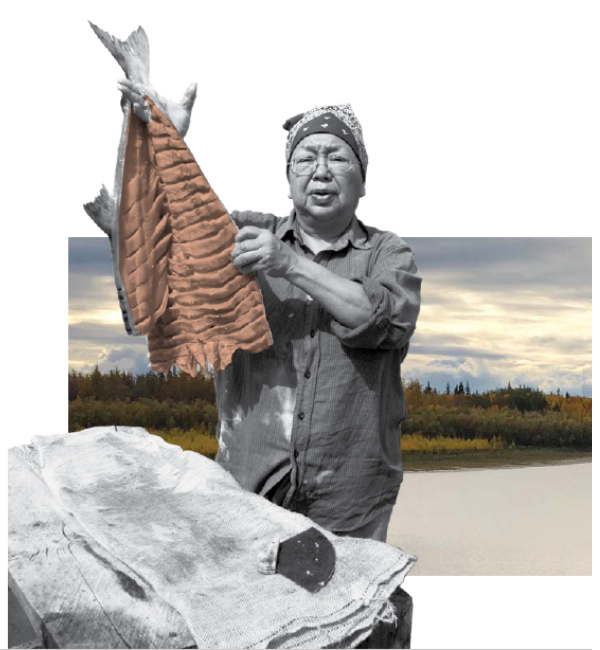
Eleanor Yatlin cutting salmon; the Koyukuk River. Angela Łot’oydaatlno Gonzalez

Eleanor Yatlin cutting salmon; the Koyukuk River. Angela Łot’oydaatlno Gonzalez
by Angela Łot’oydaatlno Gonzalez
Summer 2023, FORUM Magazine
OCEAN IN DENAAKK'E is degheyukk kk’e, according to the Koyukon Athabascan dictionary. Degheyukk is actually a loanword from the Central Yup’ik language. Spellings varied as the orthography was being developed, and one Alaska Native language to another may vary even more.
The Koyukon Athabascan people reside mainly in northwest interior Alaska. There was a time when people spoke more than one Alaska Native language. Much like Koyukon Athabascan people traded goods like hides, foods, materials, and tools with the Yup’ik and Iñupiat people, we also traded words.
Taak’edzee’aan De’oyh Denh: (proper noun) a lake near Bear Mountain on the Koyukuk River, literally “osprey’s nest place”
As a novice Denaakk’e language learner, I have much respect for our Elders, like Dr. Eliza Jones of Koyukuk, who have dedicated their lives to preserving the language. The Denaakk’e dictionary is a large and thick book where each page contains expansive definitions, knowledge, and nuanced stories. You could spend a lot of time learning about each word and the concepts embedded in this cultural repository.
Tokuh is another meaning for ocean or large body of water. Yoooaane means “a long distance across; outside of Alaska, across the ocean, overseas, foreign.” The Koyukon Athabascan people from long ago had a deep understanding of the lands and how we are connected through oceans despite being further inland.
Delbegge Ts’oolneek Denh: (proper noun) a lake on the Koyukuk River above the Huslia River, literally “place where someone grabbed a ptarmigan”
Koyukon Athabascan people are very descriptive and have Denaakk’e names for the lakes, sloughs, rivers, and tributaries along with the lands surrounding them. For instance, there are different names for each part of the Koyukuk River, like upper, lower, and areas around certain mountains. The names often tell stories of why they are named, like where birds nest or salmon spawn. We also have many words for water and different types of actions that take place or things that occur in water.
As someone who grew up on the Koyukuk River near Huslia, my love for the river runs deep. For thousands of years, it has given and sustained life to animals, plants, and humans. As a tributary of the mighty Yukon River, it feeds us and brings fish from the sea. In turn, it feeds other rivers, streams, and creeks.
Dotson’ De’oyh Denh: (proper noun) on the north bank of the Koyukuk River, 30 miles northeast of Huslia, literally “place where raven cust. places compact object [its nest]”
In fish camp, we learned about survival by cutting and drying fish, picking berries, and cooking over the fire. The salmon from the Koyukuk River is often described as tasting rich and oily. It tastes a lot different than fish from the ocean from communities like Savoonga or Toksook Bay. Even though we may be geographically distant from the ocean, we are deeply connected to it as it sustains us. ■
Angela Łot’oydaatlno Gonzalez is Koyukon Athabascan. She is originally from Huslia, Alaska, along the Koyukuk River. She loves beading, writing, and photography. She has been fortunate to travel to many communities in Alaska and enjoys sharing stories of life in Alaska, with a focus on Alaska Native culture, people, and our ways of life. She has written two children’s books, Button Up! Fall in Alaska and Koyukon Fish Camp.
The Alaska Humanities Forum is a non-profit, non-partisan organization that designs and facilitates experiences to bridge distance and difference – programming that shares and preserves the stories of people and places across our vast state, and explores what it means to be Alaskan.
November 13, 2025 • MoHagani Magnetek & Polly Carr
November 12, 2025 • Becky Strub
November 10, 2025 • Jim LaBelle, Sr. & Amanda Dale